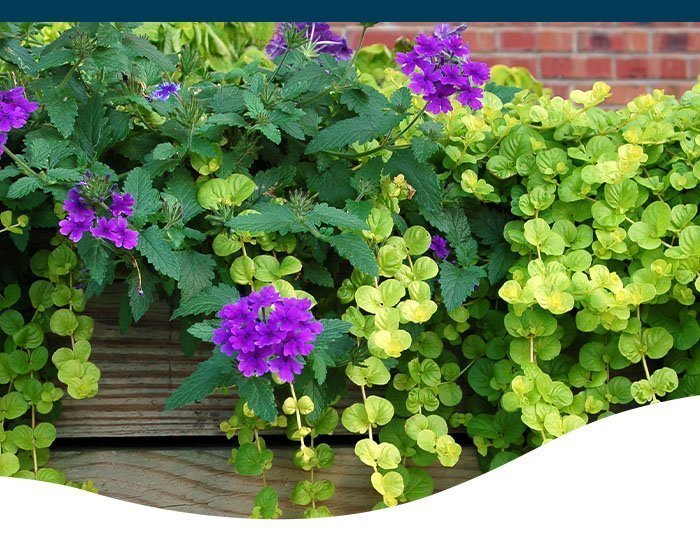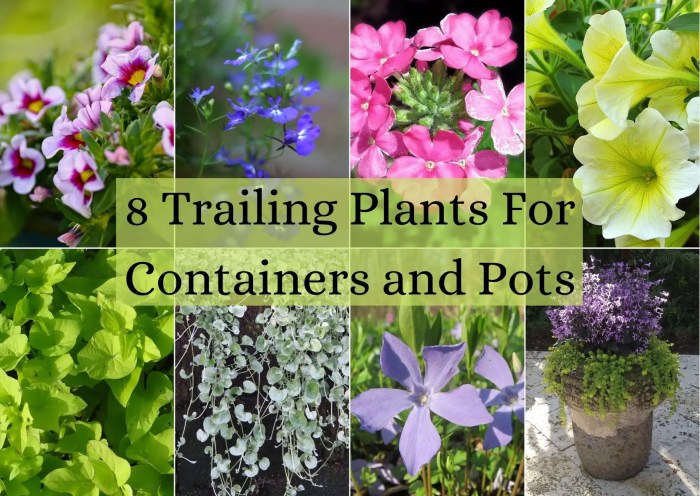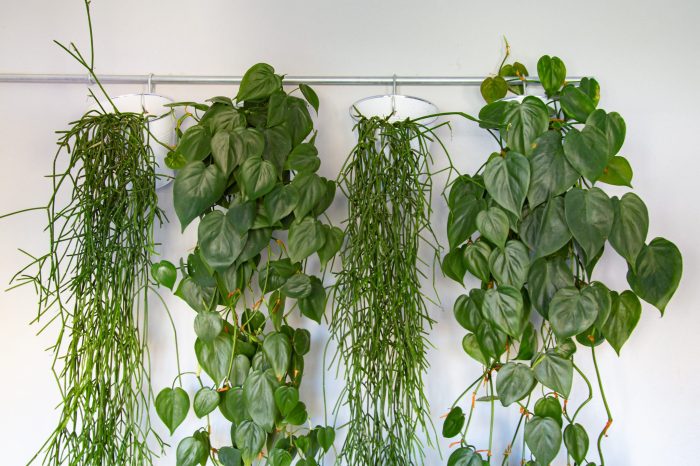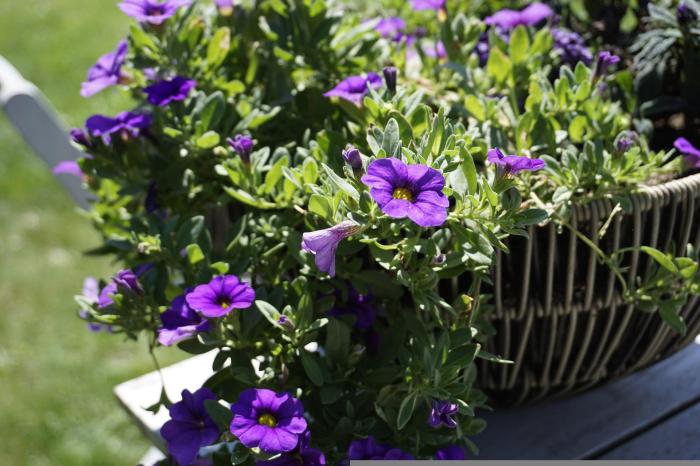Unleash the beauty of trailing plants without breaking the bank! This comprehensive guide explores the world of cheap trailing plants, revealing their versatility, ease of care, and cost-effective propagation methods.
Discover how to transform your home and garden with these affordable greenery wonders, creating lush hanging baskets, vibrant vertical gardens, and budget-friendly ground covers.
Identify Low-Maintenance Trailing Plants
For gardening enthusiasts seeking low-effort greenery, trailing plants offer an ideal solution. Known for their hardiness and minimal care requirements, these plants add a touch of elegance and charm to any indoor or outdoor space. Their ability to cascade over edges or hang from containers makes them perfect for adding a touch of nature to vertical spaces or creating lush ground covers.
For beginner gardeners or those with busy schedules, low-maintenance trailing plants are a godsend. Their resilience and adaptability make them forgiving of occasional neglect, making them an excellent choice for those who may not have ample time for gardening.
Examples of Low-Maintenance Trailing Plants
- Creeping Jenny: Known for its bright green foliage that forms a dense mat, creeping Jenny is an excellent ground cover for shady areas. Its low-growing habit and tolerance for neglect make it a favorite among beginner gardeners.
- Trailing Verbena: This vibrant plant produces clusters of colorful flowers that cascade over the edges of containers or hanging baskets. Its heat tolerance and ability to thrive in various conditions make it a popular choice for outdoor spaces.
- Ivy: With its glossy, evergreen leaves, ivy is a classic trailing plant that adds a touch of elegance to any indoor or outdoor setting. Its ability to climb walls or trellises makes it a versatile addition to any vertical space.
- String of Pearls: This unique succulent features delicate, bead-like leaves that resemble a string of pearls. Its drought tolerance and ability to thrive in bright, indirect light make it an ideal choice for indoor spaces.
- Spider Plant: Known for its long, arching leaves with variegated patterns, the spider plant is a low-maintenance plant that produces plantlets or “spiderettes” that can be easily propagated.
Explore Cost-Effective Propagation Methods

Propagating trailing plants offers a cost-effective way to expand your collection without breaking the bank. Several techniques can be employed to multiply your plants, including cuttings, division, and layering, each with its advantages and specific steps to follow.
Cheap trailing plants, such as pothos and spider plants, are a great way to add greenery to your home without breaking the bank. If you’re looking for a more dramatic look, consider some of the best hanging plants for indoor spaces.
These plants, such as ferns and philodendrons, can add a touch of elegance and sophistication to any room. Plus, they’re relatively easy to care for, making them a great choice for busy homeowners.
Cuttings
Cuttings involve taking a portion of a stem or leaf and encouraging it to develop roots, forming a new plant. This method is ideal for trailing plants with long, flexible stems, such as pothos, philodendron, and ivy. To propagate by cuttings:
- Select a healthy stem with several nodes (points where leaves or roots emerge).
- Cut the stem below a node at a 45-degree angle, using a sharp, clean knife or scissors.
- Remove any leaves from the bottom inch of the stem.
- Place the cutting in a container filled with water or moist potting mix, ensuring the nodes are submerged or in contact with the soil.
- Keep the cutting in a warm, bright location with indirect sunlight.
- Roots will typically develop within a few weeks to several months, depending on the plant species.
Division
Division is suitable for trailing plants that form clumps or have rhizomes (underground stems). This method involves separating the plant into smaller sections, each with its roots and foliage. To propagate by division:
- Gently remove the plant from its container.
- Use your hands or a sharp knife to divide the plant into smaller sections, ensuring each section has roots and foliage.
- Replant the divisions in individual containers filled with fresh potting mix.
- Water the plants thoroughly and place them in a warm, bright location.
Layering
Layering is a technique that encourages root growth on a stem while it is still attached to the parent plant. This method is particularly effective for trailing plants with flexible stems that can easily be bent and buried in the soil.
To propagate by layering:
- Select a healthy stem and make a small incision in the stem near a node.
- Bend the stem down and bury the incision in moist potting mix.
- Secure the stem in place with a wire or hairpin.
- Keep the soil moist and the stem in a warm, bright location.
- Roots will develop at the incision within a few weeks to several months.
- Once roots have formed, cut the stem below the roots to separate the new plant from the parent.
The best time of year for propagation varies depending on the plant species and climate. Generally, spring and summer are ideal as temperatures are warmer and plants are actively growing. When propagating, ensure you use clean tools and sterile potting mix to prevent disease.
Create a Lush Hanging Basket

Hanging baskets offer a charming way to add greenery and color to your indoor or outdoor spaces. Trailing plants, with their graceful cascades of foliage, are perfect for creating lush and visually appealing arrangements in these suspended containers.
When selecting trailing plants for hanging baskets, consider factors such as light requirements, growth habit, and overall size. Some popular choices include:
- Ivy (Hedera spp.)
- Pothos (Epipremnum aureum)
- String of Hearts (Ceropegia woodii)
- Spider Plant (Chlorophytum comosum)
- Trailing Jade (Senecio rowleyanus)
Once you have chosen your plants, follow these steps to create a lush hanging basket:
Planting
Line the hanging basket with a layer of sphagnum moss or coconut fiber to help retain moisture. Fill the basket with a well-draining potting mix specifically designed for container plants.
Make small holes in the potting mix and carefully remove the plants from their containers. Gently loosen any tangled roots and plant them in the holes, ensuring that the soil level is slightly below the rim of the basket.
Watering
Water the plants thoroughly after planting and allow the excess water to drain out. Water the plants regularly, allowing the soil to dry out slightly between waterings. Avoid overwatering, as this can lead to root rot.
Fertilizing
Fertilize the plants every few weeks with a balanced liquid fertilizer. Follow the instructions on the fertilizer label for the correct dosage.
Creating a Visually Appealing Arrangement
When arranging the plants in the hanging basket, consider the contrast of colors and textures. Mix plants with different leaf shapes and sizes to create a visually interesting display.
You can also use different colors of potting mix to create a more dramatic effect. For example, you could use a light-colored potting mix for the top layer and a darker-colored potting mix for the bottom layer.
Cheap trailing plants are a great way to add a touch of greenery to your home. They’re easy to care for and can tolerate a variety of conditions. If you’re looking for a plant that will add a splash of color to your home, check out our list of the best indoor hanging plants bright light . These plants are all easy to care for and will thrive in a bright, sunny spot.
Whether you’re looking for a plant to add to your living room, bedroom, or kitchen, we have the perfect plant for you.
With proper care and attention, your hanging basket will thrive and provide you with years of beauty and enjoyment.
Utilize Vertical Gardening Techniques: Cheap Trailing Plants

Maximize space and enhance the beauty of small areas by employing vertical gardening techniques for trailing plants. Trellises, arches, and hanging shelves provide support for these plants, allowing them to grow upwards.
Vertical Growth Advantages
- Space Conservation:Vertical gardening liberates ground space, making it ideal for compact balconies, patios, or small gardens.
- Aesthetic Appeal:Trailing plants cascading over trellises or hanging from shelves create a captivating visual display, transforming vertical spaces into lush green walls.
- Improved Airflow and Sunlight:Vertical growth allows for better air circulation and sunlight penetration, promoting plant health and reducing disease.
Plant Selection for Vertical Growth
Numerous trailing plants thrive in vertical settings, including:
- Ivy
- Spider plants
- Creeping Jenny
- Trailing lantana
- Verbena
Design a Budget-Friendly Ground Cover

Trailing plants offer a cost-effective and aesthetically pleasing solution for ground cover in gardens and along pathways. Their low-maintenance nature and ability to suppress weeds make them an ideal choice for budget-conscious homeowners.
When selecting trailing plants for ground cover, consider factors such as the desired growth habit, hardiness in your climate, and tolerance to foot traffic. Some popular options include creeping Jenny, vinca minor, and ajuga.
Cheap trailing plants are a great way to add some greenery to your home without spending a lot of money. They’re perfect for hanging baskets or placing on shelves, and they can help to purify the air. If you’re looking for a way to add some life to your bedroom, consider bedroom plants hanging . Trailing plants can help to create a relaxing atmosphere and can even help you to sleep better at night.
Spacing and Planting Techniques, Cheap trailing plants
Proper spacing is crucial to ensure healthy growth and prevent overcrowding. The recommended distance between plants varies depending on the species and growth habit. Generally, space plants 6-12 inches apart for dense coverage. Dig a hole twice the width of the root ball and deep enough to accommodate the roots without bending them.
Place the plant in the hole, backfill with soil, and gently firm around the base.
Maintenance Requirements
Trailing ground covers require minimal maintenance. Water regularly, especially during hot, dry weather. Fertilize lightly in spring and fall. Deadhead spent flowers to encourage new growth and prevent seed production. Mulching around the plants helps retain moisture, suppress weeds, and regulate soil temperature.
Cost-Saving Benefits
Using trailing plants for ground cover offers significant cost savings. They can help control erosion, reducing the need for expensive retaining walls or other erosion control measures. Additionally, their ability to suppress weeds eliminates the need for herbicides, saving time and money on maintenance.
Concluding Remarks

With a little creativity and these expert tips, you can effortlessly add a touch of elegance and greenery to your space without compromising your budget. Embrace the beauty of cheap trailing plants and let them bring life and style to your home and garden.
Question Bank
What are some of the most popular cheap trailing plants?
Ivy, pothos, spider plants, and wandering jew are popular and affordable trailing plants.
How can I propagate trailing plants cost-effectively?
Cuttings, division, and layering are easy and cost-effective methods for propagating trailing plants.
What are some tips for creating a lush hanging basket with trailing plants?
Use a variety of trailing plants with contrasting colors and textures, and ensure proper drainage and regular watering.